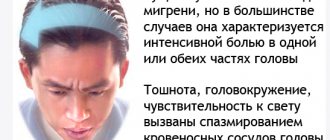It is perhaps extremely difficult to find a person who is unfamiliar with the feeling of pain in the head. Indeed, in our difficult times, when stress lurks at every turn, many of us fall victim to it. Moreover, over the past few decades, the prevalence of this unpleasant symptom has increased (Stovner LJ, Andree C., 2010). It should be noted that headaches can be caused by various reasons, depending on which their nature and intensity differ. However, no matter what the headache is and no matter what causes it, it remains a factor that can, at a minimum, ruin your mood and disrupt your work process. But you don’t have to endure a headache! What can a pharmacist advise in this situation?
Headache is a very common symptom. Thus, according to WHO, during the year 80% of the European population reported at least one attack of tension headache, and migraine - 14.9%. Interestingly, the fair sex suffers from headaches much more often than men (Manzoni GC, Stovner LJ, 2010). Thus, approximately every second person experiences a headache at least once a year. And comes with this problem...
As studies show, among patients suffering from headaches, the proportion of those who resort to self-medication is high. The prevalence of self-medication varies both depending on the region, reaching 89% in some countries (Naito Y. et al., 2009; Shehnaz SI et al., 2013), and depending on the age of the patient. For example, 43–51% of adolescents used analgesics at least once within 1 month and almost 80% of elderly patients resort to painkiller self-medication for headaches at least once a year (Lagerlov P. et al., 2009; Bronshtein A.S. ., Rivkin V.L., 2001). In this context, pharmaceutical care becomes of great importance in the work of a pharmacist, since it is often the primary pharmacist who is approached by patients with headaches.
The pharmacist must carefully question the pharmacy visitor not only about the nature and intensity of the pain, but also about the presence of accompanying symptoms, while the minimum that needs to be paid attention to and advised to see a doctor:
- intolerance to light and sounds;
- weakness, dizziness, sudden loss of balance or falling, loss of sensation or tingling sensation, difficulty speaking, confusion, vision problems;
- increased body temperature, intermittent breathing, stiff neck, rash;
- severe nausea and vomiting.
It is necessary to advise the visitor to consult a doctor if the headache is unusually intense, occurs as a result of a head injury or accident, and if the headache does not stop for more than 72 hours after taking an anesthetic.
A decent answer for headaches
Today, nonsteroidal anti-inflammatory drugs (NSAIDs) are widely used to relieve headaches, which, along with their anti-inflammatory effect, have a pronounced analgesic effect. One of the most studied representatives of this class of drugs is ibuprofen. First synthesized in 1962, the original ibuprofen is available on the European market under the brand name Nurofen®.
A strong evidence base based on data from numerous clinical studies and more than half a century of practical experience is an important argument in favor of using Nurofen® (active ingredient ibuprofen).
Why Nurofen®?
Ibuprofen has undergone many large, randomized, placebo-controlled studies to examine its effectiveness and safety profile, including for various types of headaches, particularly tension-type headaches and migraines. According to the results of a double-blind, randomized, placebo-controlled study, the onset of action of ibuprofen (400 mg) for tension headaches was noted as early as 15 minutes after administration (Schachtel BP, Thoden BP, 1988).
When using ibuprofen (the original drug Nurofen®), a rapid achievement of the maximum concentration of the active substance in the blood (35–45 minutes) and a short half-life (2 hours) without the formation of toxic metabolites are noted, which underlies its safety profile. The good duration of the analgesic effect (up to 6–8 hours) of ibuprofen allows you to achieve the desired result after taking the first dose (van den Anker JN, 2013).
It should be noted that ibuprofen is more effective compared to many other NSAIDs and non-narcotic analgesics. Thus, ibuprofen (400 mg) is significantly more effective in relieving tension headaches compared to paracetamol (1000 mg). In addition, patients receiving ibuprofen experienced an earlier and more complete reduction in pain intensity compared to the group taking paracetamol (Schachtel BP et al., 1996).
The onset of the effect 1 hour after the use of ibuprofen (200 mg) for headache is more pronounced compared to acetylsalicylic acid (500 mg) (Nebe J. et al., 1995). In addition, ibuprofen is as effective in relieving headaches as diclofenac, naproxen and ketoprofen with a more optimal safety profile (Lange R., Lentz R., 1995; Kubitzek F. et al., 2003).
Along with its proven rapid onset of action and effectiveness for headaches, ibuprofen has also been shown to be associated with fewer side effects than many other NSAIDs, as evidenced by numerous studies. Thus, taking ibuprofen is associated with a lower risk of side effects from the gastrointestinal tract compared to ketoprofen, piroxicam, naproxen, acetylsalicylic acid and some other NSAIDs (Henry D. et al., 1996; Castellsague J. et al., 2013 ).
If we talk about the risk of adverse reactions when using ibuprofen, then according to the results of a Cochrane review, it is comparable to that when taking placebo (Rabbie R. et al., 2010).
Thus, ibuprofen is the drug of choice among NSAIDs for the relief of tension-type headaches and the first-line drug in the elimination of migraine in children and adults according to the recommendations of the European Headache Federation, since it is effective while having a more acceptable safety profile ( Verhagen AP et al., 2006; Steiner TJ et al., 2007).
The successful balance of effectiveness and safety profile, confirmed by data from numerous studies, as well as the experience of use by doctors in many countries, allows us to state that ibuprofen is a rational choice for eliminating headaches of varying nature and intensity.
Nurofen det suspension i.n. prim orange 100 mg/5 ml 200 ml x1
INSTRUCTIONS for medical use of the drug NUROFEN FOR CHILDREN Trade name: NUROFEN® FOR CHILDREN
Registration number: P No. 014745/01
International nonproprietary name (INN) ibuprofen
Chemical name
(RS)-2-(4-isobutylphenyl)-propionic acid
Dosage form: oral suspension [orange, strawberry]
Description: a suspension of white or almost white color, syrupy consistency with a characteristic orange or strawberry odor.
COMPOUND
5 ml of Nurofen® suspension for children contains 100 mg of ibuprofen (active ingredient) and excipients: maltitol syrup, water, glycerol, citric acid, sodium citrate, sodium chloride, sodium saccharinate, orange flavor 2M16014 or strawberry flavor 500244E, xanthan gum, polysorbate 80, domiphene bromide.
Pharmacotherapeutic group non-steroidal anti-inflammatory drug.
ATS CODE: M01AE01.
PHARMACOLOGICAL PROPERTIES
It has analgesic, anti-inflammatory and antipyretic effects. The mechanism of action of ibuprofen is due to inhibition of the biosynthesis of prostaglandins - mediators of pain and inflammation. The effect of the drug lasts up to 8 hours.
INDICATIONS FOR USE
Nurofen" for children is used from 3 months of life to 12 years as an antipyretic for acute respiratory diseases, influenza, childhood infections, post-vaccination reactions and other infectious and inflammatory diseases accompanied by an increase in body temperature. The drug is used as an analgesic for pain of mild or moderate intensity, including: headaches and toothaches, migraines, neuralgia, pain in the ears and throat, pain with sprains and other types of pain.
Your doctor may also recommend this drug for other indications (in this case, follow your doctor’s recommendations on dosage and dosage regimen).
CONTRAINDICATIONS
Nurofen® for children should not be used if:
• hypersensitivity to ibuprofen, acetylsalicylic acid or other NSAIDs, as well as to other components of the drug, • bronchial asthma, urticaria, rhinitis, provoked by taking acetylsalicylic acid (salicylates) or other NSAIDs, • if the child has an ulcerative lesion of the gastrointestinal tract , • active gastrointestinal bleeding • with inflammatory bowel diseases, • with confirmed hypokalemia, • blood diseases: hypocoagulation, leukopenia, hemophilia, • renal and/or liver failure, • hearing loss PRECAUTIONS
You should consult your doctor before giving your child Nurofen® for children if your child:
•takes other painkillers, •has a history of: peptic ulcer, gastritis, ulcerative colitis, gastrointestinal bleeding, •suffers from liver or kidney disease, •has the presence of H. pylori •takes indirect anticoagulants (drugs for oral administration that reduce blood clotting), drugs to lower blood pressure, glucocorticosteroids, antiplatelet agents, diuretics (drugs to increase urination), lithium drugs, methotrexate, •suffers from bronchial asthma, urticaria. MODE OF APPLICATION
Nurofen® for children is a drug specially designed for children. Read the instructions carefully before using the drug. The drug is taken orally. Shake the bottle thoroughly before use. To accurately measure the dose of the drug, a convenient measuring syringe is included. 5 ml of the drug contains 100 mg of ibuprofen.
USING A MEASURING SYRINGE: 1. Insert the syringe firmly into the neck of the bottle. 2. Shake the suspension well. 3. Turn the bottle upside down and smoothly pull the plunger down, drawing the suspension into the syringe to the desired level. 4. Return the bottle to its original position and remove the syringe, carefully turning it. 5. Place the syringe in the child’s mouth and slowly press the plunger, smoothly releasing the suspension.
After use, rinse the syringe in warm water and dry it out of the reach of the child.
Fever (Heat) and pain: Dosage for children depends on the age and weight of the child. A single dose is 5-10 mg/kg of the child’s body weight 3-4 times a day. The maximum daily dose should not exceed 30 mg per kg of body weight of the child per day.
Children aged 3-6 months (child weight more than 5 kg): 2.5 ml 3 times within 24 hours, no more than 150 mg per day.
Children aged 6-12 months (average child weight 6-10 kg): 2.5 ml 3-4 times within 24 hours, no more than 200 mg per day.
Children aged 1-3 years (average child weight 10-15 kg): 5.0 ml 3 times within 24 hours, no more than 300 mg per day.
Children aged 4-6 years (average child weight 15-20 kg): 7.5 ml 3 times within 24 hours, no more than 450 mg per day.
Children aged 7-9 years (average child weight 21-29 kg): 10 ml 3 times within 24 hours, no more than 600 mg per day.
Children aged 10-12 years (average child weight 30-40 kg): 15 ml 3 times within 24 hours, no more than 900 mg per day.
Warning: Do not exceed the indicated dose. Post-immunization fever: 2.5 ml syringe for children under 1 year of age, after 1 year, if necessary, another 2.5 ml syringe after 6 hours.
Do not use more than 5 ml within 24 hours.
Duration of treatment:
•No more than 3 days as an antipyretic, •No more than 5 days as an analgesic. If fever persists, consult your doctor. SIDE EFFECTS
When using the drug, side effects are rare, but the following side effects may occur:
• from the gastrointestinal tract: nausea, vomiting, discomfort or epigastric pain, laxative effect, possible erosive and ulcerative lesions, bleeding. •allergic reactions: skin rash, itching, urticaria, exacerbation of bronchial asthma, angioedema, anaphylactoid reactions, anaphylactic shock, bronchospasm, fever, exudative erythema multiforme (including Stevens-Johnson syndrome), toxic epidermal necrolysis (Lyell's syndrome) •with aspects of the nervous system: headache, dizziness, psychomotor agitation, insomnia • cardiovascular system: tachycardia, increased blood pressure. •from the hematopoietic organs: anemia, thrombocytopenia, agranulocytosis, leukopenia. •from the urinary system: impaired renal function, cystitis. If these or other side effects occur, you should stop using the drug and consult a doctor.
OVERDOSE
Problems with an overdose are very rare, but if you accidentally exceed the recommended dose, consult a doctor immediately.
Symptoms of overdose: abdominal pain, nausea, vomiting, headache, tinnitus, metabolic acidosis, coma, acute renal failure, decreased blood pressure,
bradycardia, tachycardia. Treatment: gastric lavage (only within an hour after administration), activated charcoal, alkaline drinking, forced diuresis, symptomatic therapy.
INTERACTION WITH OTHER MEDICINES
The simultaneous use of NUROFEN® FOR CHILDREN with anticoagulants may lead to an increase in their effect. Nurofen® for children increases the concentration of digoxin, phenytoin, methotrexate, lithium in the blood plasma when used simultaneously with these drugs. Using Nurofen® for children together with diuretics and antihypertensive drugs reduces their effectiveness. Increases the side effects of mineralocorticosteroids and glucocorticosteroids.
SPECIAL INSTRUCTIONS
Nurofen® for children can be used in children with diabetes mellitus, because... the drug does not contain sugar. Does not contain dyes.
RELEASE FORM
Oral suspension [orange, strawberry] 100 mg/5 ml. A polyethylene terephthalate bottle with a low-density polyethylene or polypropylene cap and liner containing 100 ml/150 ml/200 ml of suspension.
Each bottle, complete with a dispenser syringe, is packaged in a cardboard box along with instructions for use.
STORAGE CONDITIONS
At a temperature not higher than 25°C. In a dry place. Keep out of the reach of children!
BEST BEFORE DATE
3 years. Do not use a drug that has expired.
HOLIDAY FROM PHARMACIES
Over the counter.
Thane Road, Nottingham, NG90 2DB, UK, manufactured by BSM Ltd, Thane Road, Nottingham, NG2 ZAA, UK.
Representative in Russia/address for claims Reckitt Benckiser Healthcare LLC Russia, 115114, Moscow, Kozhevnicheskaya st., 14








